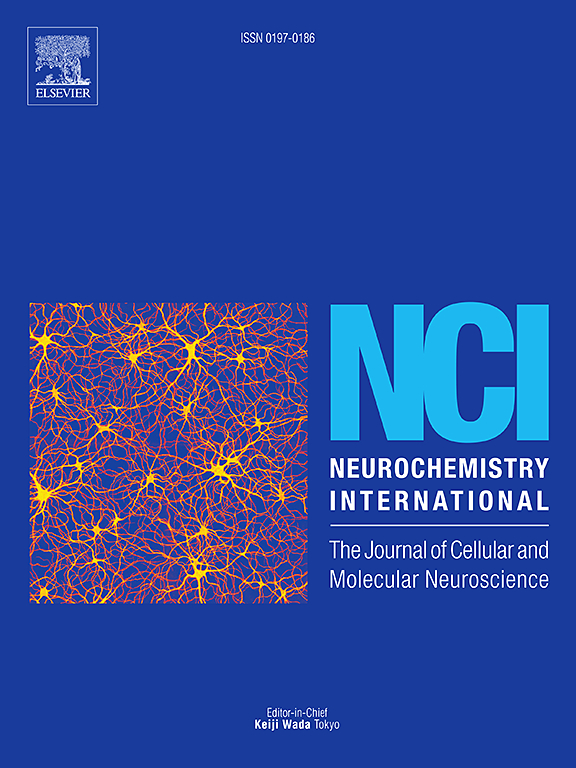母亲抑郁和抗抑郁治疗对大鼠神经递质、脑区和线粒体功能的影响
IF 4
3区 医学
Q2 BIOCHEMISTRY & MOLECULAR BIOLOGY
引用次数: 0
摘要
越来越多的证据表明,母亲在怀孕前或怀孕期间会经历压力,这会严重影响她们的gaba能系统,导致杏仁核过度活跃。虽然动物模型有望在人类中反映上述发现,但目前关于慢性不可预测的轻度应激(CUMS)对大鼠水坝的影响的知识仍然不足。因此,本研究的目的是研究CUMS诱导的海马背侧结构和神经化学变化,特别是γ -氨基丁酸(GABA)和谷氨酸(Glu)相对于总肌酸(tCr)的变化,以及抗抑郁药米氮平(MIR)治疗的效果。在两个时间点使用磁共振成像和质子定位磁共振波谱来评估这些改变的可逆性。cums后8周,慢性应激引起海马代谢和结构变化的显著改变,包括与对照组相比,GABA/tCr浓度降低和杏仁核体积增加。在MIR处理的应激大坝中,没有观察到GABA水平或杏仁核体积的变化。cums后14周,海马神经化学没有明显变化,而杏仁核的变化持续存在。此外,MIR对照组的杏仁核和下丘脑也出现了明显的时间依赖性变化。有趣的是,采用高分辨率呼吸测量法评估脑线粒体功能,仅揭示了这一组的变化。基于这些发现,我们证实了代谢物的可逆性。此外,MIR在调节神经递质水平和保护应激后杏仁核体积方面具有潜力;然而,为了充分了解其治疗效果,还需要进一步的研究。本文章由计算机程序翻译,如有差异,请以英文原文为准。
Effects of maternal depression and antidepressant treatment on neurotransmitters, brain regions, and mitochondrial function in rat dams
Increasing evidence suggests that mothers experience stress before or during pregnancy, which can significantly impact their GABAergic system and lead to amygdala hyperactivity. While animal models are expected to reflect the above findings in humans, the current knowledge on the effects of chronic unpredictable mild stress (CUMS) in rat dams remains insufficient. Therefore, the objective of this study was to investigate the structural and neurochemical alterations in the dorsal hippocampus, specifically gamma-aminobutyric acid (GABA) and glutamate (Glu) relative to total creatine (tCr), induced by the CUMS and the effects of antidepressant mirtazapine (MIR) treatment. Magnetic resonance imaging and proton localized magnetic resonance spectroscopy were used in rat dams at two time points to assess the reversibility of these alterations. Eight weeks post-CUMS, chronic stress induced significant alterations in hippocampal metabolism and structural changes, including lower GABA/tCr concentrations and an increased amygdala volume compared to controls. In stressed dams treated with MIR, no changes in GABA levels or amygdala volume were observed. Fourteen weeks post-CUMS, no significant changes in hippocampal neurochemistry were confirmed, while amygdala changes persisted in stressed dams. Moreover, significant time-dependent changes were observed in the amygdala and hypothalamus in the control group with MIR. Interestingly, high-resolution respirometry was performed to assess brain mitochondrial function, revealing only changes in this group. Based on these findings, we confirmed the reversibility of metabolite. Furthermore, MIR has demonstrated potential in regulating neurotransmitter levels and protecting amygdala volume after stress; however, further research is needed to fully understand its therapeutic effects.
求助全文
通过发布文献求助,成功后即可免费获取论文全文。
去求助
来源期刊

Neurochemistry international
医学-神经科学
CiteScore
8.40
自引率
2.40%
发文量
128
审稿时长
37 days
期刊介绍:
Neurochemistry International is devoted to the rapid publication of outstanding original articles and timely reviews in neurochemistry. Manuscripts on a broad range of topics will be considered, including molecular and cellular neurochemistry, neuropharmacology and genetic aspects of CNS function, neuroimmunology, metabolism as well as the neurochemistry of neurological and psychiatric disorders of the CNS.
 求助内容:
求助内容: 应助结果提醒方式:
应助结果提醒方式:


